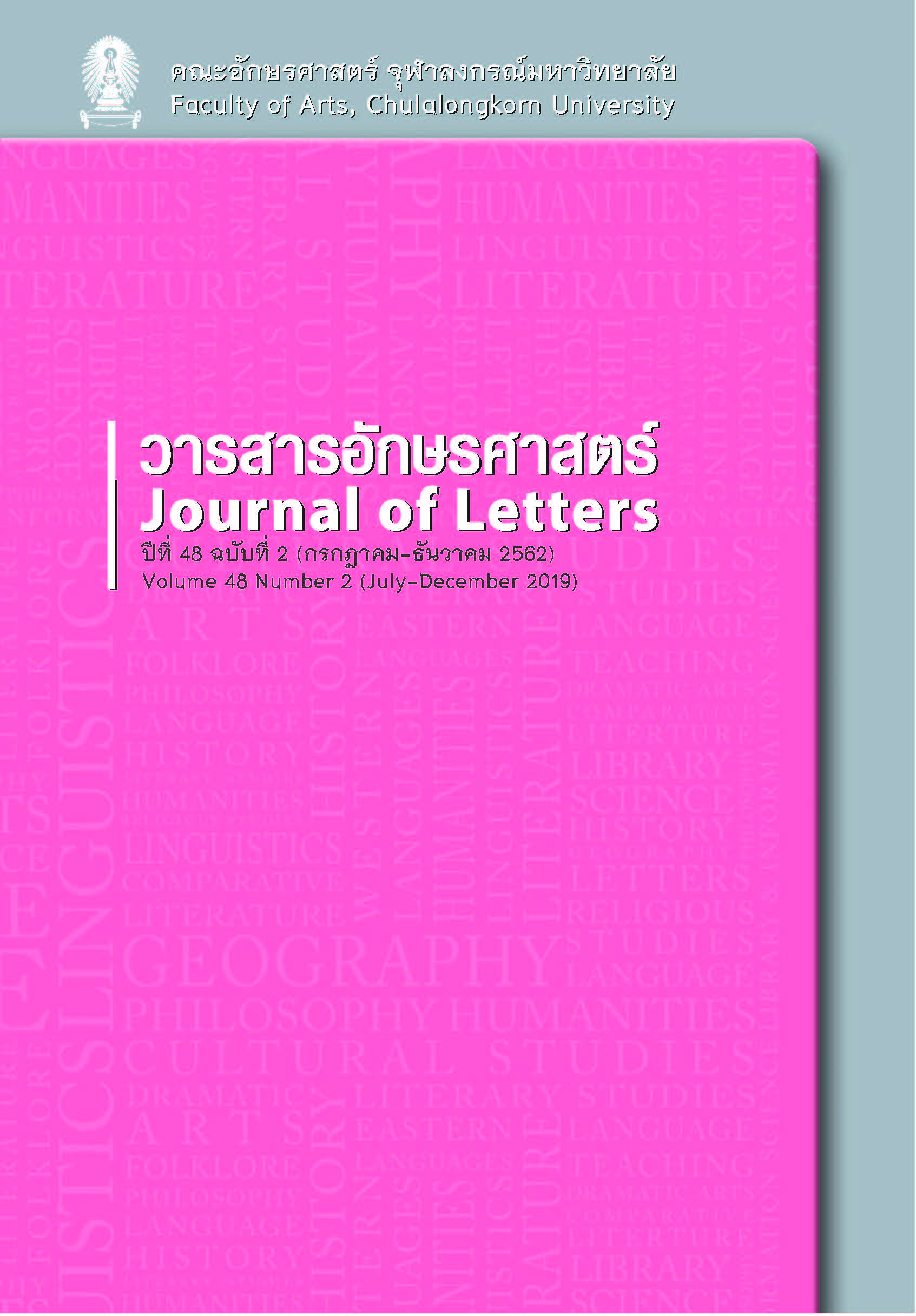In Pursuit of Vaiḍūrya in Ancient Indian Literature
Keywords:
vaiḍūrya, Indian Lapidaries, Indian Literature, Sanskrit Technical Literature, GemologyAbstract
Scholars of Indian language and literature have not been unanimous in defining the term “vaiḍūrya” as referring to the exact type of precious stone. This article is an attempt to discover the meaning of “vaiḍūrya” as it appears in ancient Indian literature. Data was collected from Sanskrit lapidaries and other relevant literary works written in Pali and Sanskrit. The study reveals that there is a textual consistency, among ancient Indian texts, particularly in the description of vaiḍūrya regarding its origin story, geographical sources and physical properties. The gemstone identification of vaiḍūrya is problematic because similes used to describe the color of vaiḍūrya in the representative samples show a wide range of analogous natural colors, i.e. green, blue and other related dull colors, which are collectively called “nīla” in Pali and Sanskrit, thus leading to a variety of interpretations. However, this study proposes that the closest equivalent gem to Sanskrit “vaiḍūrya” (or Pali “veḷuriya”) is beryl.
References
Buncha Thanaboonsombut บัญชา ธนบุญสมบัติ. 2010. ‘Athit Songklod’ Krai wa Me Khae Wong Klom’ อาทิตย์ทรงกลด' ใครว่ามีแค่วงกลม? [Does 'Sun Halo' Have a Circular Shape Only?]. Warasarn Technology Watsadu วารสารเทคโนโลยีวัสดุ [Journal of Materials Technology] 60: 61-80.
Sakda Siripant ศักดา ศิริพันธุ์. 2009. Anyamani nai Krueng Pradab อัญมณีในเครื่องประดับ [Gems in Jewelry]. Bangkok: Darnsutha Press.
Suriyawong Montri, Phraya, Wichatham, Phra Maha, Likhit Precha, Luang, Phakdi Jinda, Laung, & Chom สุริยวงศ์มนตรี, พระยา, วิชาธรรม, พระมหา, ลิขิตปรีชา, หลวง, ภักดีจินดา, หลวง, และชม. 1978. Tamra Nopparat ตำรานพรัตน์ [The Book of Ancient Lore of Nine Gems]. In Anuson nai Ngan Praratchatan Ploengsop Nai Songsak Avutthagampreecha Lae Chapanakitsop Nangsao Sudhamma Avutthagampreecha อนุสรณ์ในงานพระราชทานเพลิงศพ นายส่งศักดิ์ อาวุธกรรมปรีชา และฌาปนกิจศพ นางสาวสุธรรมา อาวุธกรรมปรีชา [The Book of Remembrance for the Royal Cremation of Mr. Songsak Avutthagampreecha and the Cremation of Miss Sudhamma Avutthagampreecha], 31-49. Bangkok: Aroonprinting.
Thai Industrial Standards Institute (TISI), Ministry of Industry สำนักงานมาตรฐานผลิตภัณฑ์อุตสาหกรรม กระทรวงอุตสาหกรรม. 1994. Sab Banyat Anyamani ศัพท์บัญญัติอัญมณี [Thai Coined Words on Gemstones]. Bangkok: TISI.
Thailand Bible Society สมาคมพระคริสตธรรมไทย. 2014. Anyamani nai Phra Khamphi อัญมณีในพระคัมภีร์ [Gems in Holy Bible]. In Phra Christatham Khamphi Thai-Angkrit Songphan Sibsong พระคริสตธรรมคัมภีร์ ไทย-อังกฤษ 2012 [Holy Bible Thai-English 2012] (3rd ed.)., 2623-2625. Bangkok: Thailand Bible Society.
Foreign
A Board of Scholars. 1978. Ancient Indian Tradition and Mythology: The Garuḍa-Purāṇa Part I. Delhi: Motilal Banarsidass.
Apte, Vaman S. 1890. The Practical Sanskrit-English Dictionary: Containing Appendices on Sanskrit Prosody and Important Literary & Geographical Names in the Ancient History of India. Poona: Arya Vijaya Press.
Böhtlingk, O., & Roth, R. 1871. Sanskrit Wörterbuch, herausgegeben von der Kaiserlichen Akademie der Wissenschaften. St. Petersburg: Eggers.
Davids, Caroline A. F. R. 1950. The Book of the Kindred Sayings (Saŋyutta-Nikāya) or Grouped Suttas Part I. London: Pali Text Society.
Davids, T. W. R., & Stede, W. 1972. The Pali Text Society's Pali-English Dictionary. London: The Pali Text Society.
Finot, Louis. 1896. Les Lapidaires Indiens. Paris: Librairie Émile Bouillon.
Ghosh, Manomohan. 1950. THE NAṬYAŚĀSTRA: A Treatise on Hindu Dramaturgy and Histrionics Ascribed to BHARATA-MUNI (completely translated for the first time from the original Sanskrit with an introduction and various notes) (Vol. I (Chapters I-XXVII)). Calcutta: The Royal Asiatic Society of Bengal.
Goldman, R. P., & Goldman, S. J. S. 1996. The Rāmāyaṇa of Vālmīki: an epic of ancient India (Vol. 5). New Jersey: Princeton University Press.
Gooneratne, E. R. 1913. The Aṅguttara Nikāya of the Sutta Piṭaka Eka Duka and Ṭika Nipāta: Translated from the Pāli Text. Galle: Lankaloka Press.
Hare, E. M. 1935. Aṭṭhanipāta, Mahāvagga. London: Luzac.
Iyer, K. A. S. 1977. The Vākyapadīya of Bhartṛhari, Kāṇḍa II : English Translation with Exegetical Notes. Delhi: Motilal Banarsidass.
Kale, M. R. (Ed.). 1917. Kālidāsa's Kumārasambhava Canto I-VII: Edited with the Commentary of Mallinātha, a Literal English Translation, Notes and Introduction (2nd ed.). Bombay: The Standard Publishing.
Knuth, Bruce G. 2007. Gems in Myth, Legend and Lore. Colorado: Jewelers Press.
Law, Bimala C. 1954. Historical Geography of Ancient India. New Delhi: Société Asiatique de Paris.
Lefeber, Rosalind. 1994. The Rāmāyaṇa of Vālmīki: An Epic Poem of India (Vol. IV). New Jersey: Princeton University Press.
Master, Alfred. 1944. Indo-Aryan and Dravidian. Bulletin of the School of Oriental and African Studies, University of London 11(2): 297-307.
Monier-Williams, Monier. 2005. A Sanskrit-English Dictionary: Etymologically and Philologically Arranged with Special Reference to Cognate Indo-European Languages. Delhi: Motilal Banarsidass.
Mookerjee, Bhudeb. 1984. Rasa-Jala-Nidhi or Ocean of Indian Chemistry, Medicine & Alchemy (2nd ed., Vol. III). Varanasi: Srigokul Mudranalaya.
Müller, Friedrich M. 1882. India: What Can It Teach Us? London: Longmans, Green, and Company.
Sarma, S. R. 1984. Ṭhakkura Pherū’s Rayaṇaparikkhā: A Medieval Prakrit Text on Gemmology. Aligarh: Viveka Publications.
Winder, Marianne. 1990. VAIDURYA. Bulletin of Tibetology New Series 26(1-3): 27-37.
Yule, H. & Burnell, A. C. 1886. Hobson-Jobson: The Anglo-Indian Dictionary. Ware Hertfordshire: Wordsworth Editions.
Downloads
Published
How to Cite
Issue
Section
License
Copyright and plagiarism
Authors are responsible for obtaining permission to use copyrighted materials from copyright owners. Authors are responsible for observing requisite copyright law when quoting or reproducing copyrighted materials. Quotations and reproductions of content from other published sources must be accompanied by a reference and all sources should be clearly listed in the references section. Quotations and reproductions of content from external sources without due attribution could be considered a severe infringement of academic conduct and may constitute a legal offence under the Copyright Act of B.E. 2537. Any legal ramifications arising from the infringement of copyright regulations would be the sole responsibility of the author(s).



